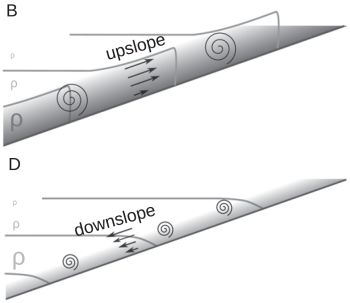
Turbulent Bottom Boundary Layers

Turbulent bottom boundary layers (BBLs) are important hotspots of energy dissipation, mixing, and transport processes in most marine and limnic systems. They often provide an essential contribution to basin-scale energy dissipation and mixing, determine the exchange of dissolved substances between the sediment and the water column, and control the transport of suspended material.
Our group has focused in the past in particular on stratification effects in oscillating boundary layers near topographic slopes, including those generated by barotropic and baroclinic tides, near-inertial waves, and so-scalled internal "seiches" (long standing internal waves) in lakes. Together with physical limnologists from the EAWAG (Switzerland), we investigated the basin-scale effects of periodically unstable boundary layers in small lakes with the help of a high-resolution numerical modeling study (Becherer and Umlauf, 2011; Lorrai et al., 2011). Using a simple one-dimensional theoretical framework, we showed how important BBL properties like the mixing effeciency and the residual transport changes as a function of forcing conditions, slope, stratification, rotation rate, and other relevant parameters (Umlauf and Burchard, 2011; Umlauf et al., 2015). As one result of this work, it turned out that oscillating boundary layers near sloping topography have many similarities with tidal straining processes in regions of fresh-water influence in estuaries and the coastal ocean. Schulz and Umlauf (2016) and Schulz et al. (2017) showed that asymmetries in turbulence in oscillating BBLs result in residual sediment transports, which are likely to occur everywhere in the ocean where a stratified oscillating flow occurs in the vicinity of sloping topography.